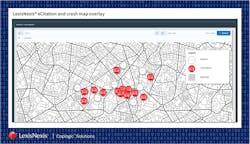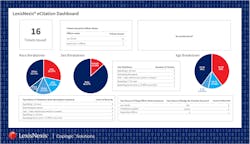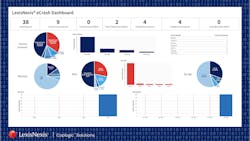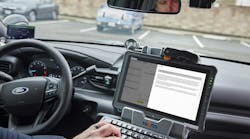Law enforcement has relied on data for decades now, but as analytics and technology continue to make gains, agencies are finding that they can do more to collect and use data faster. Software solutions offer ways to tackle serious public safety issues such as vehicle crashes, helping zero in on problem spots to create a more strategic plan of action.
Roy Marler, VP of Client Engagement for LexisNexisCoplogic Solutions, spoke to OFFICER Magazine about how law enforcement agencies can use technology to not only clear crash scenes quicker but help them pinpoint hotspots, leveraging process automation and advanced data and analytics with visualizations.Assisting law enforcement
Marler has been working since 1996 to help solve the crash reporting challenge and has been with LexisNexis Risk Solutions since 2005. In 2010, LexisNexis formed the Coplogic Solutions line of business to help law enforcement agencies gain a force multiplier through automation and efficiency.
“Our mission over the years has been to assist law enforcement agencies with the collection and distribution of crash reports in a more efficient manner by alleviating administrative tasks,” he says. “A lot of my team are former and active-duty law enforcement officers. Our focus at Coplogic Solutions is essentially all about traffic safety and helping agencies collect data, then understand the data so they can identify ways to save lives.”
Advancements such as electronic crash and electronic citation applications that are delivered through a single sign-on cloud-based platform, and voice-to-text transcription, are giving agencies tools to get their jobs done faster—not only more efficiently, but more effectively in the face of a 20-year high in traffic fatalities. “Our electronic crash data collection tool, can assist officers with inputting a driver’s name information by scanning a driver’s license,” he says. “Our applications also can scan a VIN, and vehicle registration bar code that helps prefill crash details. Seamless data collection helps complete the reports much more quickly to help clear the scene of an accident more quickly, improving the overall traffic flow and community and officer safety.Data as a resource
Data becomes a more readily available resource when it’s collected electronically at the crash scene enabling mapping, trending, reporting and dashboard analytics through the Coplogic platform. Marler says agencies can advance their traffic safety strategies from a reactive stance, to a more proactive situation and ultimately to a preventive strategy so they can significantly reduce traffic fatalities. “Multiple robust dashboards highlight accident and traffic trends by cause, age and other factors that offer a better understanding of the root causes of accidents. Having the ability to sort by causation factors and weather conditions provides actionable insights, leading to better decisioning based on accurate and factual data that ultimately leads to improved traffic safety.”
According to Marler, the platform has already proven to be a gamechanger by being more configurable with less technical requirements to allow law enforcement agencies to make simple configuration changes to their forms. “They can create simple forms, such as a tow form using our applications. We developed it with the goal of allowing agencies to configure reports exactly like they want it so it’s efficient in the collection of data and does not require a developer on staff to make those types of changes,” he says. “That’s where the technology has evolved the most. We have native mobile apps today for collecting crash and citation data at the scene. We’re getting very good feedback from our customers.”
Historically, if there was a required change to a form that came down from the state or their local jurisdiction, agencies could find themselves waiting weeks or months for a simple change to be made through a third-party vendor or development team. Marler says that what this platform does is give agencies the necessary autonomy to make these changes on their own in order to easily create, edit and manage their own forms.
Officers can start a crash report, or citation, from a mobile device and then finish it on a laptop in their patrol vehicle. For larger incidents, such as a multi-vehicle crash on a freeway, an officer can collect data using a mobile device at the scene while another officer completes the report in a cruiser. “It really is very beneficial to help improve accuracy while also clearing the crash scene much sooner than could be done historically,” Marler says.
Through software solutions like eCrash and eCitation, law enforcement agencies are able make data-driven decisions and provide more transparency with officers and their communities. “The technology can enable law enforcement agencies to build better relationships with the community by really starting with data,” he says. “Strategic traffic safety and community outreach programs begin by gathering and understanding the data. If a law enforcement agency is using our applications to collect data from a crash and or citation, they now have the ability to integrate multiple data sources to assist in the analytics of that data.”Data and policing
Marler notes that while crash data in policing has always been a valuable resource, it has been difficult to sufficiently analyze in a timely fashion. “Today’s user-friendly technology has really removed a lot of barriers or limitations and I think we’re going to see data usage in policing continue to grow,” he says. “I think we are in the early stages of understanding crash data and the importance of citation data. If agencies are using our collection tools, they gain the ability to run a report on any field of data that is collected on a crash report.”
Marler recognizes law enforcement officers today can find themselves at the roadside manually gathering information. “That can be a pretty cumbersome and potentially dangerous process,” he says. Marler says that the key to leveraging crash and citation data effectively is automating and simplifying the process in a user-friendly way. “In the end, crash and citation process automation can not only alleviate the administrative burden for the staff, command staff, and officers, but the cherry on top is a more strategic traffic safety program that prevents crashes and saves more lives.”






